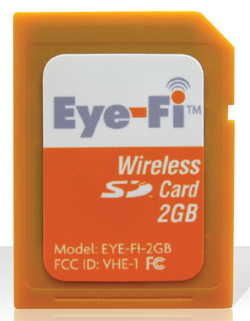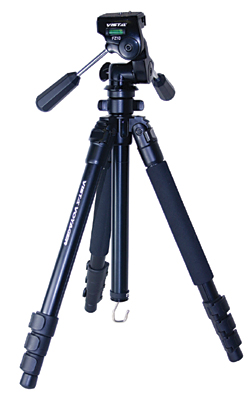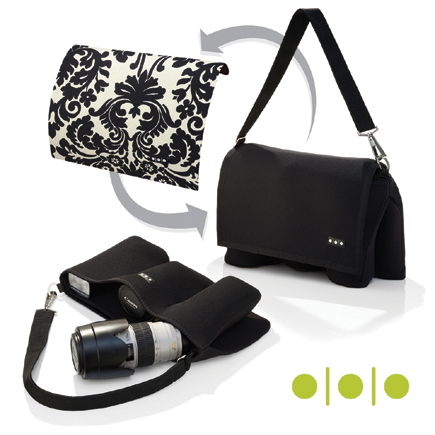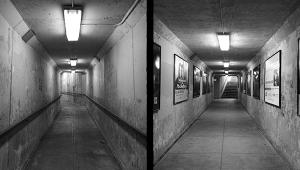PMA 08; Weird & Wonderful
One of the coolest things about wandering the cavernous halls of PMA is having the opportunity to snoop around and discover fascinating items where you'd least expect to find them. Just keep your eyes peeled and you'll be rewarded with fascinating tidbits, ranging from strange photo accessories to clever upgrades of traditional items, to exciting new technologies, some with vast upside potential.
Eye-Fi's Wireless Memory Card
The Eye-Fi Wireless Memory Card, a product of Eye-Fi of Mountain View, California,
is a 2GB SD card that includes not only the usual memory capacity for storing
images, but also a Wi-Fi transmitter/receiver, an antenna, and a complete operating
system for uploading the images to a computer or social networking website for
printing or sharing. The Eye-Fi Card uses your home Wi-Fi network to upload
images automatically from inside your camera to your PC or Mac without any cables,
cradles, or other physical connections. Nikon will include circuitry in the
new D60 D-SLR that recognizes when an Eye-Fi card is installed and facilitates
the uploading of images. The card, which can upload to leading sites, including
Shutterfly, Flickr, Snapfish, Facebook, and many others, is available online
directly from Eye-Fi or at leading retailers' websites. MSRP: $99.95.
 |
|
|
Remotest Remote Control?
The Argraph Twin1 R3-UT Max is not named after the CEO's Uncle Max. This
clever infrared (IR) remote earns its title from being able to fire your shutter
from up to 330 ft away, max, and has the added capability of operating a delayed
shutter release and connecting to compatible cameras for bulb release. For cameras
with built-in IR sensors the Twin1 R3-UT Max is claimed to provide more than
triple the operational range of competitive IR transmitters, and features multiple
camera compatibility for Nikon, Canon, Pentax, and Samsung cameras simultaneously.
It also includes a cable release for wired shutter release function for cameras
having a shutter release port. One center button fires the camera shutter and
it supports instant and half shutter release AE/AF functions. The transmitter
is powered by an easy-to-replace, long-life CR123A battery; the receiver takes
a CR2032--and, wonder of wonders, batteries are included. MSRP for set,
including transmitter and receiver: $119.95.
 |
|
|
Re-Engineering The Travel Tripod
We've seen travel tripods before but the Vista Voyager (Tiffen) provides
a very cool combination of size, features, ingenuity, and price. It's
a lightweight aluminum grounder tripod (minimum height 11") featuring
a three-way adjustable pan-and-tilt FZ10 head; four-section, three-position,
26.5mm diameter snap-lock legs; and bubble levels on the head and yoke. It's
even got a directional compass set into the tripod base! Other features: quick
lift two-section, 12" long, 28mm diameter centerpost with wing lock control
for rapid adjustment and locking; bottom centerpost hook; and a padded carrying
bag. Designed for airline travel, the Voyager extends to 58", weighs only
3.8 lbs, and folds to 21". MSRP: $119.95; $129.95 with ball head.
 |
|
|
Shootsac: Practicality Meets High Fashion
The Basic Shootsac is an innovative lens bag claimed to be the first of its
kind that optimizes style, comfort, and convenience when shooting. The attractive
bag has six vertical pockets that can safely and conveniently hold 3-6 lenses
and other "must-have" accessories such as a cell phone and memory
card wallet. The Basic Shootsac includes a black neoprene cover, but optional
True Color Covers can be added to change the look or coordinate with your attire.
It's lightweight, folds flat for easy transportation, and its "wetsuit-grade"
neoprene is designed to cushion your body and your equipment. MSRP: $179.
 |
|
|
Tag Your Digital Images With Location Data
ATP Electronics of Sunnyvale, California, unveiled the Photo Finder, a compact,
battery-powered receiver that can automatically sync location data anywhere
in the world for photos made with a digital camera. The process, known as Geotagging,
embeds the location data into the EXIF metadata recorded on a memory card. Two
versions of the Photo Finder are available, one for SD, SDHC, MMC, or Memory
Stick PRO, the other for CompactFlash cards. Either one lets you access the
geographic coordinates of any image taken, without having to download the images
to a computer. For the system to work, you do have to synchronize your camera
with the clock in the Photo Finder so the data will match up properly.

































